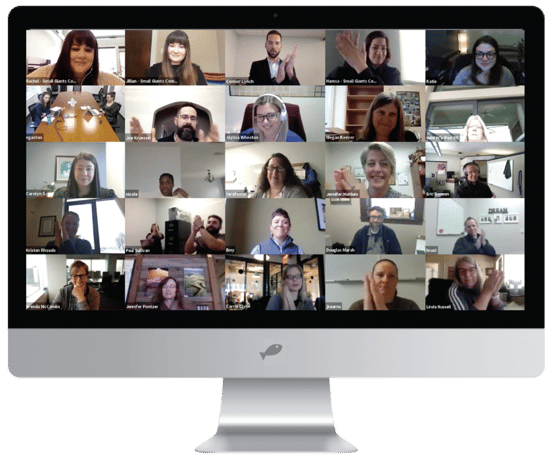Work, Kids and a Pandemic: How to Juggle it All and How Employers Can Help
Are you a parent with school-aged children at home? Or a leader with team members who have young children? Chances are you’re pretty stressed out right now — managing work and home life just got a whole lot harder, and with many schools switching to partial or fully remote learning, it’s a long road ahead.
With so many (awesome!) parents in the Small Giants Community — leaders, emerging leaders, and employees alike — we want to do our part to tackle this challenge as a community. We rolled out the welcome mat to our Zoom room to bring working parents and leaders together for a casual, open roundtable discussion to share strategies for managing work and family stress, supporting team members with children, and how to approach homeschooling as a working parent.
Here are the top takeaways and highlights from our roundtable discussion on how to juggle work, kids, and a pandemic.

Tools & Resources At A Glance:
- Collect feedback from employees: OfficeVibe
- Mindfulness program for teams: Healthy Minds Innovations
- Parenting Training: Positive Parenting Solutions
- Employee Assistance Programs (EAP)
Supporting Team Members with Kids at Home
For parents with kids at home for the long-term, you're going to need a strategy that goes beyond offering flexible work hours. During our roundtable, Small Giants leaders shared how they're supporting working parents right now and how to deliver individualized support across your team.

Survey Your Team Members
At imageOne, Connie Farlow and Emmy Georgeson offered a people-driven approach to supporting team members. Their management team is hard at work to develop creative scheduling, emotional support tools and more, but all of their efforts stem from what they're hearing from employees through surveys.
"We're surveying employees and asking tactical and emotional questions," says Georgeson. "We're creating a matrix of the results so we can objectively understand their challenges. From there, we'll build out an action plan to address the different needs."
Increased One-on-Ones
Likewise, Sabrina White shared how her organization, Text-Em-All, is taking a multi-pronged approach to supporting their small team of about 35 employees. First, they made sure every team member was set up for success working from home — from having the right length ethernet cable to excellent chairs, desks, and keyboards, every team member has what they need. Next, they meet with every team member to find out what their ideal work situation is and customize a plan for each person.
"They tell us what they want and we communicate the performance requirements for their role," says White. "We then work with them to come up with a plan and a schedule that allows them to meet their performance goals while also meeting the needs of their home and family lives."
From there, managers meet with team members on a weekly or monthly basis to discuss what's working and what needs adjusting, and to check in on employees' mental health and well-being. It's a time-consuming approach, but it's helping them maintain productivity while also caring for employees. And don't forget that just because people are at home, it doesn't mean that they're more relaxed.
"People are stressed, but they're not taking time off," says White. "We are actively encouraging time off. We have a flexible PTO schedule already, so we're reminding people to take a day or more off. Even if you just sit on your couch all day and watch Netflix with your kids, you need to take time for yourself."
Don't Neglect those without Children
Remember: we're all experiencing a pandemic, and it's impacting everybody differently. As you provide extra support to team members with children, don't neglect those who may be shouldering the extra burden from parents who need to take some projects off of their plates.
"In one-on-ones, we ask those without home challenges about the additional workload they may have picked up," says White. "You have to have transparency and vulnerability across the board: talk to all of your team members and communicate. These are the people keeping you afloat."
At Atomic Object, Brittany Hunter shared that they offer an Employee Assistance Program that allows employees to anonymously contact a counselor for personal problems. The organization foots the bill, and they never find out who uses the program — just how many people use it per month.
"We talk about it a lot so there's no barrier," says Hunter. "We've put a spotlight on mental health lately and send email communication spotlighting the different resources available to them and sharing mental health information."
Give Your Zoom Room a Break
While increased one-on-ones are a great way to keep the lines of communication open, be thoughtful about how and when you're putting meetings on a working parent's calendar.
"A word of caution," says Jason Kreger of Aladdin Electric Inc. "Make sure that your “check-ins” aren’t just one more meeting that they have to make work into their day."
Brittany Hunter echoes Jason's sentiment. A one-on-one won't serve its intended purpose if its just adding additional stress to an employee's day.
"Be thoughtful about whether video is necessary for certain meetings," says Hunter. "We’ve started doing our executive 1:1 calls on the phone instead, which allows us to go for a restorative walk or load the dishwasher or fold laundry while we sync up. Sometimes you need to be near the computer or have visual cues, but sometimes you don’t."
Returning to the Office? Bring the Kiddos Back, Too
For those working in essential businesses or who are returning to the office, shifting school schedules present a new challenge. If you're going back to the office but your kids are attending school remotely, how can you juggle both?
"We're back in the office, and 25 percent of our population have kids they need to homeschool or conduct remote learning for," says Melissa Chapman of Radio Distributing Co. "We’re asking each parent individually what is a good fit for them. We're also opening up some of our offices here and having parents set their kids up for homeschooling in our empty offices."
Make Parenting Part of Your Business Strategy
Realistically, things aren't changing anytime soon — we don't know when school schedules will return to normal, or when the age of physical distancing will be over. That means one-off strategies and ad-hoc adjustments to accommodate our new normal just won't cut it anymore.
Business advisor Jon Dwoskin shared some advice for how to implement family-friendly practices organization-wide to set your team up for longterm success:
-
- You don't want your team members who are parents to feel like an exception to the rule. Get everyone together and talk about a vision for the company that accounts for parents with kids at home and homeschooling.
- Get aligned with a 3-year vision and a set of values that define what flexibility means for your organization so there's a common understanding of what flexibility looks like in practice. You want your team members to feel like they can come into work and do a great job, while still getting through these tough times at home.
- We’re going to be in this for awhile — it’s worth formally doing a leadership offsite and creating clarity, accountability, and definition around what work looks like from here on out. There’s enough uncertainty and loss right now without adding work into the mix.
- It's the responsibility of the leadership team to redefine the foundation of the company and define all of these elements in a living document.
- Doing this work sends a strong message to your team that their home lives and well-being are a priority.
- Share stories to set an example and communicate what success looks like. Tell stories about a time when an employee spoke up about not having a good day and how you were able to support them. Give kudos to people who do what you hope others will do.

Routines, Boundaries and Making Snack Time Better
There's one subject that made our Zoom room's chat blow up: snack time. As attendee Jean-Paul Lausell of Hickory Nut Gap Farm shared, his four-year-old and six-year-old are raiding the pantry constantly — and he even had to put a lock on their fridge. Attendees agreed: it feels like they're constantly making meals, dishes quickly pile up, and their kids are constantly asking: "Can I have a snack?"

With everyone in your family home 24/7, boundaries and routines are more important than ever. Here are a few tips for making snack time and other feeding routines better:
- Make snack sacks. It takes more time in the morning, but put together a sack for each child that has all of their snacks for the day, their lunches — everything. Every time your kids say they’re hungry, you can point to the bag and they know those are their snacks for the day. It helps you maintain boundaries and helps make the kids more self-sufficient.
- Meal prepping. Meal prepping can save you a lot of time. Christina Moore of Taylor English Duma recommends determining your meals for the week on Sunday and prepping as much as you can (i.e., peel the carrots, make pancakes and freeze them). That way, your meals throughout the week are prepped almost to completion.
- One cup per day. Up to your elbows in dirty dishes? Christina Moore has a strategy for limiting her kids to one cup per day. "We have cheap, kid cups for them to use, and I give them a marker and have them write their names on their cup," says Moore. "That’s your cup for the day. This helps keep dishes to a minimum."
- Snack boxes. If constant interruptions are curbing your productivity, try snack boxes with your kids. Put a ‘snack box’ on the counter with snacks that your kids can eat anytime without asking — the rest is off limits.
- Family meal deliveries. This one's an idea for employers: have your organization treat its employees to a family meal delivery every so often. It is very exciting for the kids and parents will welcome the break.
- Use visual aids. Mimic a school room environment and hang charts on the wall or other tactile items that communicate your daily schedule. If your kids can’t tell time, link snack time and other meals to certain shows they watch. You can use a bulletin board to have them move a visual cue when it's time for a snack or lunch. This helps them regulate time and makes boundaries easier to set.
- Work out together. Are you finding it hard to take care of yourself physically right now? Christina Moore added her kids to her workout routines in order to keep prioritizing her physical health. "I scarified my alone time in order to help me continue my personal care," says Moore. "Now they go on bike rides and runs with me."
- Use a concierge service. Many organizations offer a concierge service as part of its benefits package (and if not, now's a good time to consider one!). Parents can use these services for one-off support like running errands, buying groceries, or meal prep. Having the service already set up saves them the time of seeking out reliable services and they can quickly get help with just a click of a link.
It's been a trying year for all of us, but one thing is clear: we're stronger when we stick together. We're so impressed by the ideas, empathy, and creativity demonstrated by parents and the employers who support them. There are more challenges ahead, and we're here to connect you to the relationships, ideas, and tools to keep succeeding.
We have virtual workshops, resources and learning opportunities designed to help you and your team members thrive. Consider us a resource for you, and please don't hesitate to reach out directly at hello@smallgiants.org.





Submit Your Comment